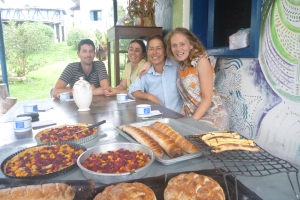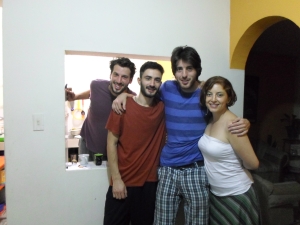 It was in the Zona Cafetera we undertook our third farming ‘apprenticeship’ on our long road towards being fully fledged farmers. Thanks to having spent four months working on other farms and most of our time cycling through the countryside, it was refreshing to arrive feeling like we had some knowledge and insights to offer. The farm, El Albergue Azul, came at the perfect time in our journey towards agricultural enlightenment. The farm focuses on food sovereignty: prioritising growing food to eat rather than for profit. The relaxed order that comes from farming organically in this manner has created a vibrant haven of biodiversity, tucked away among the monoculture of coffee farms that surrounds it. It is a blueprint for the RebSolomon farm of the future.
It was in the Zona Cafetera we undertook our third farming ‘apprenticeship’ on our long road towards being fully fledged farmers. Thanks to having spent four months working on other farms and most of our time cycling through the countryside, it was refreshing to arrive feeling like we had some knowledge and insights to offer. The farm, El Albergue Azul, came at the perfect time in our journey towards agricultural enlightenment. The farm focuses on food sovereignty: prioritising growing food to eat rather than for profit. The relaxed order that comes from farming organically in this manner has created a vibrant haven of biodiversity, tucked away among the monoculture of coffee farms that surrounds it. It is a blueprint for the RebSolomon farm of the future.
However, even the coffee – from which th region takes its name – isn’t safe from the inexorable march of ‘progress’. With only two international airports within an hours drive (and a population in the local city of 400,000), it has been deemed necessary to construct a third, ‘relocating’ a town and unfortunately meaning that the tranquility we found at the farm has a shelf life.
On El Albergue Azul, we saw what life on your own established self-reliant farm  could look like. The work is still physically demanding, with a lot of time spent weeding, hoeing, pruning, digging and caring for the animals, but we also saw the reward. Plentiful fresh, unprocessed food: fruit, vegetables, seeds, grains and milk. From these, we made bread, cheese, jam, pies and cakes. Volunteering here, we felt the sense of empowerment through living a creative, resourceful and more independent life in the fresh air.
could look like. The work is still physically demanding, with a lot of time spent weeding, hoeing, pruning, digging and caring for the animals, but we also saw the reward. Plentiful fresh, unprocessed food: fruit, vegetables, seeds, grains and milk. From these, we made bread, cheese, jam, pies and cakes. Volunteering here, we felt the sense of empowerment through living a creative, resourceful and more independent life in the fresh air.
The rhythm of life on the farm, lacking a timetable or sense of urgency, filtered into our downtime as well. Sunday was rest day, and despite knowing there were plenty of things we could (/should) have done, the day was filled up by talking, cooking, reading and watching the clouds.
In order to fully commit ourselves to this way of life, we needed to stop asking visitors from the UK to bring us chocolate, and rid ourselves of our current supplies. Our evenings on the farm were thus dedicated to this task, one 500g bar a night.
It wasn’t easy, but we finished our supply just in time for the arrival of Andrew, Sol’s cousin, here to travel Colombia for a couple of months before settling down as a journalist in Medellin. By the time he arrived with us, Andrew had  already mastered the Spanish subjunctive tense, unintentionally hitched a lift with a family car he mistook for a bus (!) and got a step further than merely finding the police station where we had arranged to meet; he was napping in the policeman’s bedroom when we arrived. Andrew threw himself into Colombia. In our first weekend together, he danced (twice) with a septuagenarian neighbour and convinced us to jump a spiked gate to reach the music of what he was sure would be a banging party. The four people (and their mini hi-fi) we found having dinner eyed us bemusedly as we walked past pseudo-casually, then had to double back home, to brave the gate again.
already mastered the Spanish subjunctive tense, unintentionally hitched a lift with a family car he mistook for a bus (!) and got a step further than merely finding the police station where we had arranged to meet; he was napping in the policeman’s bedroom when we arrived. Andrew threw himself into Colombia. In our first weekend together, he danced (twice) with a septuagenarian neighbour and convinced us to jump a spiked gate to reach the music of what he was sure would be a banging party. The four people (and their mini hi-fi) we found having dinner eyed us bemusedly as we walked past pseudo-casually, then had to double back home, to brave the gate again.
Andrew turned out to be better at Colombian culture than English. To make up for his inability to cook while we were on the farm together – due to a vague  ‘allergy to the countryside’ – Andrew and his friend Ricky attempted to cook Sol a birthday dinner. Confidence was running high, verging on cockiness, with Andrew crowing that ‘this cooking lark is easier than I thought’ as he dumped a packet of pasta into the saucepan. What could go wrong? Well…rectangles of clumped spaghetti, prised from the bottom of the pan…
‘allergy to the countryside’ – Andrew and his friend Ricky attempted to cook Sol a birthday dinner. Confidence was running high, verging on cockiness, with Andrew crowing that ‘this cooking lark is easier than I thought’ as he dumped a packet of pasta into the saucepan. What could go wrong? Well…rectangles of clumped spaghetti, prised from the bottom of the pan…
A new Colombian experience we all shared was a Temazcal with our friend Juliana who we had returned to visit in Pereira. A Temazcal is an indigenous ceremony which takes place in a low, igloo-like structure made of a bamboo framework covered with heavy cloths. As the initial thirteen stones are brought one by one inside the tent, having been heated overnight in a fire, the space starts to fill with heat and steam. During the ceremony, we played musical instruments while  singing and chanting, broken by intervals of discussion and instruction by the indigenous elder, when the door is opened to let in a rush of cool air. We repeated this three more times, with each new round of stones increasing the heat. The heat of the first round was comparable to a hot steam room, and the fourth, nearly four hours later, had escalated to approaching unbearable.
singing and chanting, broken by intervals of discussion and instruction by the indigenous elder, when the door is opened to let in a rush of cool air. We repeated this three more times, with each new round of stones increasing the heat. The heat of the first round was comparable to a hot steam room, and the fourth, nearly four hours later, had escalated to approaching unbearable.
The aims of the Temazcal are similar to those of meditation, with an additional physical aspect of cleansing. The extremes of temperature and the contrast of the heat with the cool air when the door is opened made us much more aware of our bodies – our heart rate, our breathing – and physical sensations, from the cool of the packed earth beneath us, to the saltiness of each drop of sweat, even to the intensity of the sound of the tambourines. The play of shadow and silhouette in the steam, coupled with the music, at times made the atmosphere almost eerie. We were guided to reflect on our relationships and goals, and rid ourselves of negative thoughts and feelings to make space for a more positive future.


Andrew: Getting that past subjunctive going now… that bloody heat thing was mental! See you in Medellin soon!!
Pingback: Colombia: Wyalades On Holiday | RebSolomon